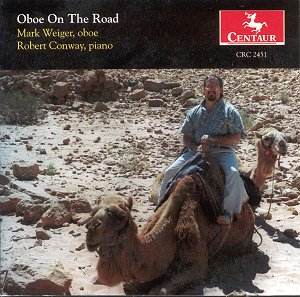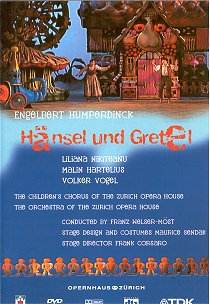 Composer: Miguel del Águila, Robert Sibbing, David Gompper, Michael Angell, Arnold Rosner, Walter Piston
Composer: Miguel del Águila, Robert Sibbing, David Gompper, Michael Angell, Arnold Rosner, Walter Piston
Works: Sommergesang (1988), Ballad, Blues & Rag, Anon (1984), Noon Song (1985), Oboe Sonata (1972), Suite (1931)
Performers: Mark Weiger (oboe), Robert Conway (piano)
Recording: July 1998, Cornell College, Mt Vernon, Iowa DDD
Label: Centaur CRC 2451
The album “Oboe on the Road” presents an intriguing cross-section of modern compositions for the oboe, showcasing the instrument’s versatility and emotional depth through a selection of works from the late 20th century. The composers featured—ranging from the Uruguayan Miguel del Águila to the American Walter Piston—each bring distinct stylistic influences to their pieces, reflecting broader trends in contemporary classical music while also drawing on historical antecedents. This recording, performed by oboist Mark Weiger and pianist Robert Conway, invites listeners to explore the rich tapestry of sound and sentiment that defines this repertoire.
Del Águila’s “Sommergesang” opens the disc with a compelling contrast between pastoral lyricism and visceral intensity. The oboe initially leads with a soaring, lyrical line reminiscent of the American jazz idiom, before the piano interjects with a more dissonant and jagged counterpoint. This interplay highlights the symbiotic relationship between the instruments, where the piano is not merely accompaniment but an equally vital voice. The work’s emotional landscape, characterized by sudden shifts from tranquility to turbulence, encapsulates the composer’s reflections on the tumultuous aspects of nature. Weiger’s execution of the oboe line is both expressive and technically assured, navigating the piece’s complexities with a nuanced approach that captures its dualities.
Robert Sibbing’s “Ballad, Blues & Rag” provides a delightful contrast, with each section distinctly embodying its titular genre. The Ballad unfolds with a languorous, soulful quality, while the Blues section allows for a more improvisational feel, showcasing Weiger’s ability to infuse character into each phrase. The Rag evokes a lively, syncopated energy that is reminiscent of Scott Joplin, allowing the performers to display their rhythmic agility and playful interaction. Conway’s piano accompaniment is both supportive and vibrant, complementing the oboe’s dialogue while maintaining its own rhythmic drive.
David Gompper’s “Anon” introduces a more dissonant flavor, with angular melodies and a stark interplay between the instruments. The piano’s aggressive, sometimes jarring attacks contrast sharply with the oboe’s more lyrical passages, creating a dialogue that feels both confrontational and reflective. The performance captures the work’s unsettling textures, allowing listeners to engage with its darker emotional undertones.
Michael Angell’s “Noon Song” returns to a more gentle, reflective space, characterized by a delicate interplay of timbres. The oboe’s soft, lisping phrases evoke a sense of introspection, while Conway’s understated piano lines provide an ethereal backdrop. This piece stands out for its lyrical beauty and simplicity, a testament to Angell’s ability to evoke profound emotion through minimalist means.
Arnold Rosner’s Oboe Sonata is a significant addition to the repertoire, showcasing the instrument’s range and emotional capacity. The Adagio is particularly noteworthy for its tragic undertones, where Rosner’s lush harmonies and flowing melodies evoke a deeply personal narrative. The performers navigate the intricacies of this sonata with finesse, particularly in the finale, where rhythmic complexity and thematic interplay reach a compelling climax.
Walter Piston’s Suite, with its contrasting movements, encapsulates the emotional spectrum of the album. The Prelude and Gigue frame a series of introspective, slower movements that explore shadowy depths of feeling. Piston’s ability to blend lyrical expressiveness with structural integrity is manifest in these pieces, and Weiger and Conway’s performance captures this duality, making each transition feel purposeful and impactful.
The recording quality is commendable, with a clear balance between the oboe and piano that allows the subtleties of both instruments to shine through. The engineering captures the warmth of the oboe’s tone while preserving the piano’s percussive clarity, creating an immersive listening experience.
The breadth of works on “Oboe on the Road” not only showcases the oboe’s versatility but also illustrates the rich tapestry of contemporary classical music. Each piece invites listeners to engage with a variety of emotional landscapes, from the tranquil to the tumultuous. Weiger and Conway’s performance is marked by technical proficiency and interpretative insight, making this album a valuable addition to the discography of modern oboe repertoire. Their ability to navigate diverse styles while maintaining a cohesive artistic vision ultimately positions this recording as a noteworthy exploration of the oboe’s capabilities in the contemporary music scene.



